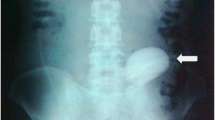Abstract
The inability to deflate a self-retaining balloon catheter is a rare problem but may be encountered by physicians. Many techniques have been described to solve the problem, some of which may be dangerous. The technique must not disturb the patient or create any additional morbidity. Those methods commonly used are the instillation of ether, liquid paraffin, chloroform or mineral oil through the inflation channel; the use of a fine wire to burst the balloon or to recanalize the obstructed inflation channel; bursting or deflating the balloon through suprapubic, transvaginal or urethral routes: and the overinflation technique. The techniques which might be most appropriate for women are explained in a stepwise manner. First the catheter is cut in the proximal segment of the valve. If this is not successful, a ureteric catheter stylet is advanced through the inflation channel until it touches the balloon. If this is still unsuccessful, the balloon is deflated through the drainage channel using the technique proposed by Davies and Thomas. As a second choice, an intravenous cannula with its inner needle drawn back is advanced through the urethra next to the catheter, towards the balloon which, is then punctured with the inner needle. If these steps are followed, the patient will have no additional discomfort and no trauma to the surrounding tissues, and there will be no need for cystoscopy or any other expensive intervention.
Similar content being viewed by others
References
Moffat LEF, Teo C, Dawson I. Ultrasound in management of undeflatable Foley catheter balloon.Urology 1985;26:79
Carr LK. An alternative to manage a nondeflating Foley catheter in women.J Urol 1995;153:716–717
Chin PL, Singh RK, Athey G. Removal of retained urinary catheters.Br J Urol 1984;56:185–187
Gülmez I, Ekmekçioglu O, Karacagil M. A comparison of various methods to burst Foley cathether balloons and the risk of free-fragment formation.Br J Urol 1996;77:716–718
Gattegno B, Michel F, Thibault PH. A serious complication of vesical ether instillation: ether cystitis.J Urol 1988;139:357–358
Murphy GF, Wood DP Jr. The use of mineral oil to manage the nondeflating Foley catheter.J Urol 1993;149:89–90
Sood SC, Sahota H. Removing obstructed balloon catheter.Br Med J 1972;4:735
Browning GGP, Barr L, Horsburgh AG. Management of obstructed balloon catheters.Br Med J 1984;289:89–91
Ross WB. Management of obstructed balloon catheters (letter).Br Med J 1984;289:319
Hessl JM. Removal of Foley catheter when balloon does not deflate (letter).Urology 1983;22:219
Vandendris M. How to deflate refractory balloon of a bladder catheter.Urology 1985;26:300
Addonizio JC, Sayegh N, Sayegh N. Management of undeflatable Foley catheter balloon.Urology 1982;19:318
Moisey CU, Williams LA. Self retained balloon catheters — a safe method for removal.Br J Urol 1980;52:67
Banerjee AK. Removal of retained Foley catheter.Br J Urol 1993;71:363
Kleeman FJ. Technique for removal of Foley catheter when balloon does not deflate.Urology 1983;21:416
Chrisp JM, Nacey JN. Foley catheter balloon puncture and the risk of free fragment formation.Br J Urol 1990;66:500–502
Hukins DWL, Hickey DS, Kennedy AP. Catheter encrustation by struvite.Br J Urol 1983;55:304–305
Simson JNL. Management of obstructed balloon catheters (letter).Br Med J 1984;289:319
German K, Crossman I. A method to avoid bursting the blocked catheter balloon in the female patient.Br J Urol 1995;76:657–658
Davies BW, Thomas DG. Management of non-deflating Foley catheters in women — a new technique.Br J Urol 1994;74:117
Khan SA, Landes F, Paola AS, Ferrarotto L. Emergency management of the nondeflating Foley catheter balloon.Am J Emerg Med 1991;9:260–263
Arkell DG. Management of obstructed balloon catheters (letter).Br Med J 1984;289:319
Mukhtar AM, Orr G. Management of obstructed balloon catheters (letter).Br Med J 1984;289:319
O’Flynn KJ, Thomas DG, Hardy A. Harpoon device for removal of obstructed balloon catheters.Br J Urol 1992;69:217
Saxena A, Khanna S, Vohra BK. Endoscopic management of undeflatable Foley catheter balloon.Br J Urol 1992;69:217–218
Author information
Authors and Affiliations
Rights and permissions
About this article
Cite this article
Gülmez, I., Ekmekçioglu, O. & Karacagil, M. Management of undeflatable foley catheter balloons in women. Int Urogynecol J 8, 81–84 (1997). https://doi.org/10.1007/BF02764823
Issue Date:
DOI: https://doi.org/10.1007/BF02764823




